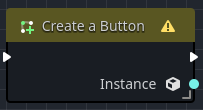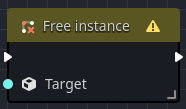Memory
Memory nodes are used to dynamically allocate and free objects in an Orchestration.
For example, you may add a Button to your user interface and based on some interaction, remove the button from the scene.
In this case, you would use a New node to create the button and the Free node to free it.
These nodes are currently considered experimental
While it's okay to use these nodes, be aware that their implementation may change in the future.
Creating objects
The New or Create Instance node is responsible for creating a new instance of a given object.
You can use this node to allocate a new instance of a any Node, Resource, or Object type, as long as the type is not a singleton.
To create a New or Create Instance node:
- Right-click in the graph to access the All Actions view.
- Search for
New, locating theMemory > Newnode. - Either press the Add button or simply hit Enter.
- In the Inspector view, select the desired
Class Namefrom the inspector, defaults toObject.
Godot's Object selector window shows all possible object class names; however, not all choices can be used.
If the class name is a singleton, i.e. OS, this value will not be accepted and you will need to select another value.
Properties
| Property | Description |
|---|---|
| Class Name | Specifies the class name of the object to be created. |
Freeing objects
The Free or Deallocate Instance node is responsible for destroying an instance of a given object.
This node uses a combination of queue_free(), memdelete, and unreference() to deallocate the object based on its type.
For example, if the node is still in the scene tree, the queue_free() method is used.
If the object is a Resource, the unreference() method is used because resources are reference counted.
To create a Free or Deallocate Instance node:
- Right-click in the graph to access the All Actions view.
- Search for
Free, locating theMemory > Freenode. - Either press the Add button or simply hit Enter.
- Connect the object to be freed to the input
Targetpin.

